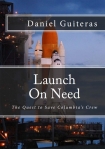Launch on Need, Daniel Guiteras [the giving tree read aloud TXT] 📗

- Author: Daniel Guiteras
Book online «Launch on Need, Daniel Guiteras [the giving tree read aloud TXT] 📗». Author Daniel Guiteras
The press tour of the OPF was going to be done in small closely guarded groups. Stangley’s group had just 10 reporters, all of whom Stangley had met in the past, though he figured a few of them might not remember who he was due to his long absence. Stangley felt like the old guy who was expected to retire to make room for the newcomers. However, he could not think of anyone in his line of work, certainly no one in this current group, who shared his passion for the space program.
The group had already gathered as instructed at the entrance to the OPF near the aft end of Atlantis—all except Stangley, who had walked underneath Atlantis in an attempt to see her left wing up close. He was hoping to better visualize the area where Columbia had been damaged.
“We’re ready to start when you are,” the guide said loudly, hoping Stangley would hear him. The guide knew that besides being the most popular science guy on CNN, and arguably any network for that matter, Stangley was a dying breed of old-school space fanatics. He knew that Stangley knew enough about the space shuttle to know what was off limits during processing, and that he respected NASA enough to actually follow the rules. He thought for a moment that NASA could actually use a few more reporters like Stangley. Realizing Stangley clearly had not heard him above the ambient noise in the OPF, the guide left the group briefly to retrieve Stangley.
Stangley had been making his way forward, walking under the belly of Atlantis, and he was now craning his neck, trying to examine the RCC panels of Atlantis’s wing. “Just trying to get some perspective on the wing damage,” Stangley said as he saw the guide coming toward him. “It’s all about perspective, you know.”
“Well, if you want perspective, you’ll need to join the rest of us. I can’t have you wandering off,” the guide said. “We need to get going.”
Back with the group, the guide wasted no time in beginning his tour.
“Okay, here we go, we’re ready to start. Sorry your camera crews couldn’t come along. We simply can’t accommodate everyone and their equipment right now. The press kit you downloaded from our website outlines how you can obtain NASA file footage of the OPF. My plan today is to show you as much as I can, but we will need to stay clear of the workers. Vehicle processing is running a very rushed schedule, as you can imagine.
“Now, for those of you who might be here for the first time, you should know that the OPF functions as a service center for NASA’s fleet of orbiters. The OPF’s role in the shuttle program begins soon after an orbiter returns from space. After an orbiter lands and is ‘safed’—that is, any hazardous fluids are removed—the orbiter gets towed into one of the three high-bays. Here we perform maintenance, tile repairs, system checks, equipment updates, payload-bay unloads and reloads, et cetera—just about anything that an orbiter needs for its next mission gets done here in the OPF.”
The guide didn’t say it, but he made it clear to the group in his tone and body language that Stangley and his colleagues were in a special place, and lucky to be there. They were witnessing history in the making. Sensing that some of the younger reporters did not quite get it, the guide stopped the group again and said, “Please keep in mind that never before in the history of manned spaceflight has NASA or any other space agency used one manned spacecraft to rescue the crew of another.”
The guide paused, then he turned and pointed up to Atlantis’s three main engines.
“Each engine bell of the three main engines measures seven-and-a-half feet in diameter. The bright red cover you see over each engine bell signifies that engine has been closed out for this mission; in other words, all the maintenance, parts replacement and engine system checks have been performed—it’s ready to go. The covers also serve to prevent any foreign-object damage, and will remain in place at least until Atlantis is hoisted into the vertical position, next door, at the vehicle assembly building.”
The guide then led the group along the length of Atlantis toward the forward end and to a set of stairs that gave access to the first platform. All along the way were posters and banners of various sizes that cheered, “Go Get ’Em Atlantis.”
As the group climbed the stairs, the underside and nose of Atlantis grew closer, close enough for them to touch her protective tiles. Being last up the stairs and feeling that he was visually blocked from the guide by the others, Stangley readied his hand at his side. He was ready to touch the tiles—he really couldn’t stop himself. He felt he needed the connection, like a crazed fan doing whatever it took to touch the hand of his favorite performer.
As he neared Atlantis, he rotated his forearm outwardly, preparing to lay his hand flat against her cool belly. Then, he reached for her, and caressed her tiles with his palm and fingers. Smooth, then a seam. Smooth, then a seam. Unique scales that covered an engineering marvel.
Stangley imagined the launch of Atlantis, the rendezvous with Columbia, and finally the landing. He was certain that his connection to Atlantis would be stronger from having touched her today.
Chapter 31
BROWN AND THE PHOTO GUYS were busy, too. In the next two weeks in preparation for the launch, they needed to test all cameras, especially for proper focus and alignment. They also would ready themselves for





Comments (0)